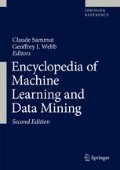Access this chapter
Tax calculation will be finalised at checkout
Purchases are for personal use only
Notes
- 1.
Most of the topics covered in this entry have more detailed entries in this encyclopedia, namely “Inductive Logic Programming,” “Graph Mining,” “Relational Data Mining,” and “Relational Reinforcement Learning.” These entries provide a brief introduction to these more specific topics and appropriate references for further reading. Direct relevant references to the literature include the following. A comprehensive introduction to ILP can be found in De Raedt’s book (De Raedt 2008) on logical and relational learning, or in the collection edited by Džeroski and Lavraè (2001) on relational data mining. Learning from graphs is covered by Cook and Holder (2007). Džeroski and Lavraè (2001) is also a good starting point for reading about multi-relational data mining, together with research papers on multi-relational data mining systems, for instance, Yin et al. (2006), who present a detailed description of the CrossMine system. Statistical relational learning in general is covered in the collection edited by Getoor and Taskar (2007), while De Raedt and Kersting (2003) and De Raedt et al. (2008) present overviews of approaches originating in logic-based learning. An overview of relational reinforcement learning can be found in Tadepalli et al. (2004).
Recommended Reading
Most of the topics covered in this entry have more detailed entries in this encyclopedia, namely “Inductive Logic Programming,” “Graph Mining,” “Relational Data Mining,” and “Relational Reinforcement Learning.” These entries provide a brief introduction to these more specific topics and appropriate references for further reading. Direct relevant references to the literature include the following. A comprehensive introduction to ILP can be found in De Raedt’s book (De Raedt 2008) on logical and relational learning, or in the collection edited by Džeroski and Lavraè (2001) on relational data mining. Learning from graphs is covered by Cook and Holder (2007). Džeroski and Lavraè (2001) is also a good starting point for reading about multi-relational data mining, together with research papers on multi-relational data mining systems, for instance, Yin et al. (2006), who present a detailed description of the CrossMine system. Statistical relational learning in general is covered in the collection edited by Getoor and Taskar (2007), while De Raedt and Kersting (2003) and De Raedt et al. (2008) present overviews of approaches originating in logic-based learning. An overview of relational reinforcement learning can be found in Tadepalli et al. (2004).
Bratko I (2000) Prolog programming for artificial intelligence, 3rd edn. Addison-Wesley, Reading
Cook DJ, Holder LB (2007) Mining graph data. Wiley, Hoboken
De Raedt L (2008) Logical and relational learning. Springer, Berlin
De Raedt L, Kersting K (2003) Probabilistic logic learning. SIGKDD Explor 5(1):31–48
De Raedt L, Frasconi P, Kersting K, Muggleton S (2008) Probabilistic inductive logic programming. Springer, Berlin
Džeroski S, De Raedt L, Driessens K (2001) Relational reinforcement learning. Mach Learn 43:7–52
Džeroski S, Lavraè N (eds) (2001) Relational data mining. Springer, Berlin
Finn P, Muggleton S, Page D, Srinivasan A (1998) Pharmacophore discovery using the inductive logic programming system PROGOL. Mach Learn 30:241–270
Getoor L, Taskar B (2007) Introduction to statistical relational learning. MIT Press, Cambridge
Horváth T, Ramon J, Wrobel S (2006) Frequent subgraph mining in outerplanar graphs. In: Proceedings of the 12th ACM SIGKDD international conference on knowledge discovery and data mining. ACM, New York, pp 197–206
Jensen D, Neville J (2002) Linkage and autocorrelation cause feature selection bias in relational learning. In: Proceeding of the 19th international conference on machine learning, University of New South Wales, Sydney. Morgan Kaufmann, San Francisco, pp 259–266
Jensen D, Neville J, Gallagher B (2004) Why collective inference improves relational classification. In: Proceedings of the 10th ACM SIGKDD international conference on knowledge discovery and data mining, Philadelphia. ACM, New York, pp 593–598
Kersting K (2006) An inductive logic programming approach to statistical relational learning. IOS Press, Amsterdam
Krogel M-A, Rawles S, Železný F, Flach P, Lavraè N, Wrobel S (2003) Comparative evaluation of approaches to propositionalization. In: Proceedings of the 13th international conference on inductive logic programming, Szeged. Springer, Berlin, pp 194–217
Lloyd JW (2003) Logic for learning. Springer, Berlin
Muggleton S (1996) Stochastic logic programs. In: De Raedt L (ed) Advances in inductive logic programming. IOS Press, Amsterdam, pp 254–264
Richardson M, Domingos P (2006) Markov logic networks. Mach Learn 62(1–2):107–136
Sato T, Kameya Y (1997) PRISM: a symbolic-statistical modeling language. In: Proceedings of the 15th international joint conference on artificial intelligence (IJCAI 97), Nagoya. Morgan Kaufmann, San Francisco, pp 1330–1335
Tadepalli P, Givan R, Driessens K (2004) Relational reinforcement learning: an overview. In: Proceeding of the ICML’04 workshop on relational reinforcement learning, Banff, pp 1–9
Washio T, Motoda H (2003) State of the art of graph-based data mining. SIGKDD Explor 5(1):59–68
Yin X, Han J, Yang J, Yu PS (2006) Efficient classification across multiple database relations: a CrossMine approach. IEEE Trans Knowl Data Eng 18(6): 770–783
Author information
Authors and Affiliations
Editor information
Editors and Affiliations
Rights and permissions
Copyright information
© 2017 Springer Science+Business Media New York
About this entry
Cite this entry
Struyf, J., Blockeel, H. (2017). Relational Learning. In: Sammut, C., Webb, G.I. (eds) Encyclopedia of Machine Learning and Data Mining. Springer, Boston, MA. https://doi.org/10.1007/978-1-4899-7687-1_719
Download citation
DOI: https://doi.org/10.1007/978-1-4899-7687-1_719
Published:
Publisher Name: Springer, Boston, MA
Print ISBN: 978-1-4899-7685-7
Online ISBN: 978-1-4899-7687-1
eBook Packages: Computer ScienceReference Module Computer Science and Engineering

